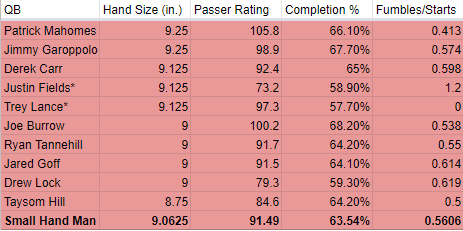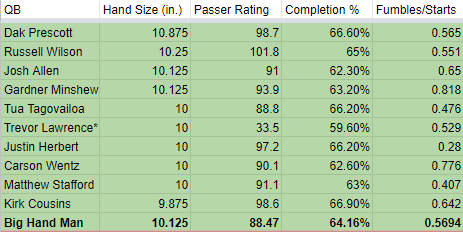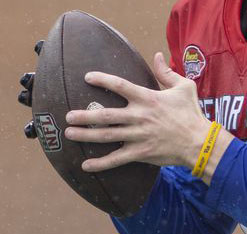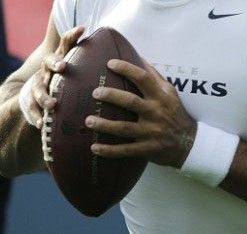Recent news from the Combine regarding Kenny Pickett‘s small hand size has rekindled the flame of the hand size argument. Pickett’s hands measured at 8.5-inches, which puts him in the 1st-percentile of hand size among NFL QBs. There has been recent success of small-hand quarterbacks with Joe Burrow, who has a 9-inch hand size. Even Patrick Mahomes has a hand size of 9.25-inches, which still falls in at the-21st percentile. However, the concern comes in because Pickett would have the smallest hands among all 32 starting quarterbacks. And while there has been success by quarterbacks with small hands, it is still a predictive measurement. Especially in harsh weather games. At least, that’s what we’ve come to learn so far. But is that fact starting to come into question? Just how important is QB hand size?
Why Is QB Hand Size Important?
From the above two pictures, you can see what a huge difference two inches can make when it comes to holding a football. Russell Wilson appears to have a much better grip on the ball than Kenny Pickett does. That is where is the concern is.
The logic of hand size is that bigger hands = better grip on the football = better QB performance. It is also important to remember that even 8.5-inch hands are still pretty big hands. Just not when compared to other NFL quarterbacks. The average hand-size of an adult American male is 7.6-inches according to NASA. According to ESPN, the average QB hand size for players drafted from 2008-2020 is 9.7-inches. The circumference of an NFL football is roughly 21-inches. When holding a football, you want to be able to grip around 40-50-percent of the ball. That would translate to about 8.4 to 10.5-inch hands. So Pickett still falls into the acceptable hand size range, but it is dangerously close. Let’s take a look at how QBs have produced relative to their hand size in today’s NFL.
The Metrics
I made a list of relevant NFL QBs after the recent free agency signings and trades and compiled their hand sizes from PlayerProfiler. Then I made a chart featuring the 10 QBs with the smallest hands, and the 10 QBs with the largest hands. After that, I went to Pro Football Reference and grabbed data points for what seems to be the best metric of ball control in the NFL. Those stats being passer rating, completion percentage, and fumbles (lost and recovered) per start.
I chose passer rating so that we could have a metric demonstrating overall QB performance, completion percentage because a better grip should lead to a better control of the ball which should then lead to a more accurate pass, and fumbles because dropping the ball is the best indicator of whether or not you had control of the ball. It stands to reason that a bigger hand would be less likely to lose control of the ball as they should have a stronger grip. So without further ado, let’s take a look at these charts.
Note: The charts do include rookies, who by nature provide a small sample size.
The Small Hand QBs

One thing to note is that these are NFL QBs, so the numbers will be pretty average no matter what. However, it is important to show that QBs with smaller hands can succeed. The Small Hand Man’s passer rating of 91.49 would put him at QB18 for the 2021 NFL season according to ESPN. That would put him right between Jared Goff and Matt Ryan, which is the very definition of average.
While there are negative outliers in Justin Fields and Drew Lock, they are offset by the positive outliers in Joe Burrow and Patrick Mahomes. Trey Lance does however impact the fumbles/start stat as he had zero in his very limited action last season. Removing him from that stat would put the fumbles/start at 0.623. That is about a 10-percent higher chance of a fumble per start compared to the Big Hand Man shown below. Using 0.623 instead of 0.56 for the Small Hand Man’s fumbles/start essentially gives you Jared Goff. Take into account that Kenny Pickett has hands 0.5-inch smaller than Goff’s and you can understand why his draft stock has taken a hit. Let’s move on to the Big Hand QBs.
The Big Hand QBs

At a glance, there isn’t much difference between the averages. However, there is an outlier in Trevor Lawrence that really brings the passer rating down. Without him, the Big Hand Man would have a passer rating of 94.57. There were enough negative circumstances around Lawrence’s season last year that it makes sense to at least not fault his big hands for the bad passer rating.
A passer rating of 94.57 would put the Big Hand Man at QB14. That would place him between Teddy Bridgewater and Carson Wentz. Not bad, but also not too different from Jared Goff. We are still looking at a tier 2 QB either way, the differentiation being that the Big Hand Man is at the top of the tier while the Small Hand Man is at the bottom. That can amount to a sizeable difference in SuperFlex leagues, but maybe not so much on the NFL field.
Dropping the Mike
The only 8.5-inch hand QB that comes to mind is Michael Vick. You may be thinking “Wow, so that means Kenny Pickett is fine!” That just isn’t the case. Pickett has nowhere near the rushing capability that Vick did to make up for it. Or frankly even the arm strength, as Vick had a cannon for an arm. Let’s plug Vick’s stats into the same charts from earlier to see how he would fare.
Wow. A passer rating of 80.4 would put Vick as the 28th-best QB in the 2021 season, between Baker Mayfield and Justin Fields. A completion percentage of 56.2-percent would put him at the QB31 spot, between Justin Fields and Zach Wilson. Combine those stats with the fact that Vick carried an 85-percent chance of fumbling every start, and you have a recipe for disaster. Again, it is counted as a fumble regardless if it was recovered by the defense or not. But that is still the ball potentially being lost because of poor grip. Luckily for Vick, he also ran for 6,109 yards and 36 touchdowns in his career to make up for it. Pickett will not do that.
Conclusion
To answer the question of “Does hand-size matter for a QB?”- yes it does. A quarterback with big hands will produce a better passer rating, completion percentage, and less fumbles per start than a quarterback with small hands- on average.
To answer the question of how much hand-size matters, it depends on the athlete. A small-hand QB does carry a 10-percent higher chance of fumbling, but what can he do to make up for that? Michael Vick‘s answer was mobility. Patrick Mahomes‘ answer was improvisation. Small hands are by no means a disqualifier, but there is a learning curve for sure. It remains to be seen what Kenny Pickett‘s answer will be to make up for his hand size, but it will be intriguing to watch. His career will hopefully give us another case study and help us finally put this debate to bed. Until then however, we have nothing more than hopes and expectations. According to the data, we can reasonably expect Pickett to at least have a lower completion percentage and more fumbles than his peers.
Hand size is just one of many metrics that can be used to predict performance. It is not the metric, however it does have some credence to it. The world of football is nearly impossible to predict, but understanding the importance of certain stats and metrics can help with our predictions. Hand size is just merely one metric to take into account when evaluating possible quarterback success. We have seen success from QBs with smaller hands, but they have conquered the problem in some form. That’s what being an athlete is all about. Overcoming your shortcomings is what truly makes you a good quarterback. Unfortunately for us though, tenacity is impossible to measure.






